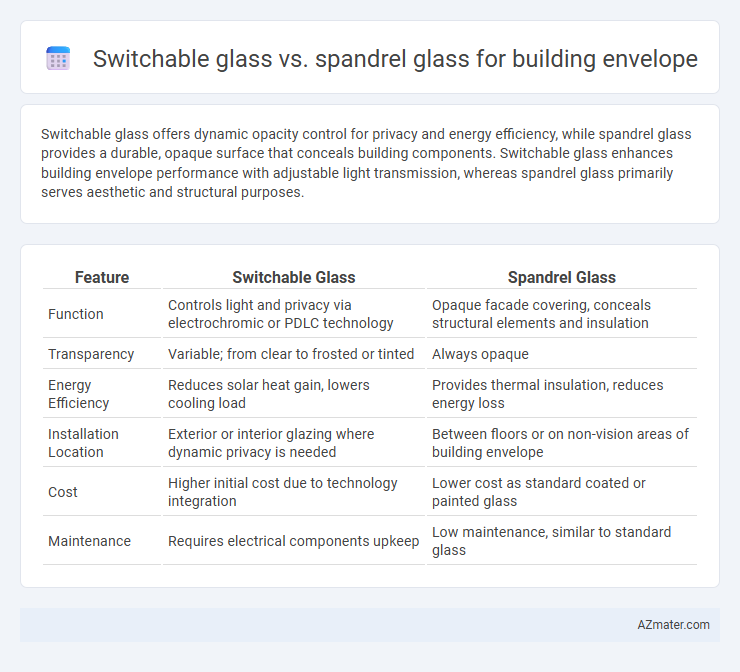Switchable glass offers dynamic opacity control for privacy and energy efficiency, while spandrel glass provides a durable, opaque surface that conceals building components. Switchable glass enhances building envelope performance with adjustable light transmission, whereas spandrel glass primarily serves aesthetic and structural purposes.
Table of Comparison
| Feature | Switchable Glass | Spandrel Glass |
|---|---|---|
| Function | Controls light and privacy via electrochromic or PDLC technology | Opaque facade covering, conceals structural elements and insulation |
| Transparency | Variable; from clear to frosted or tinted | Always opaque |
| Energy Efficiency | Reduces solar heat gain, lowers cooling load | Provides thermal insulation, reduces energy loss |
| Installation Location | Exterior or interior glazing where dynamic privacy is needed | Between floors or on non-vision areas of building envelope |
| Cost | Higher initial cost due to technology integration | Lower cost as standard coated or painted glass |
| Maintenance | Requires electrical components upkeep | Low maintenance, similar to standard glass |
Introduction to Switchable Glass and Spandrel Glass
Switchable glass, also known as smart glass, can change its light transmission properties when an electrical current is applied, providing dynamic control over privacy and solar heat gain within building envelopes. Spandrel glass is an opaque or reflective glass panel typically used to conceal structural elements, insulation, or mechanical equipment between floors while maintaining a uniform exterior appearance. Both materials serve distinct functional and aesthetic roles in modern building facades, with switchable glass enhancing energy efficiency and occupant comfort, and spandrel glass contributing to architectural continuity and concealment.
Key Differences Between Switchable and Spandrel Glass
Switchable glass, also known as smart glass, allows for dynamic control of transparency and light transmission, enhancing energy efficiency and occupant comfort by reducing glare and heat gain. Spandrel glass is an opaque panel used to conceal structural elements or mechanical systems in building envelopes, providing a uniform exterior appearance without light transmission. Key differences lie in functionality, with switchable glass offering adjustable transparency for daylight management, whereas spandrel glass serves purely aesthetic and concealing purposes with fixed opacity.
How Switchable Glass Works in Building Envelopes
Switchable glass in building envelopes operates through electrochromic technology, which allows the glass to change transparency levels when an electrical voltage is applied, effectively controlling solar heat gain and glare. This dynamic control enhances occupant comfort and energy efficiency by reducing reliance on HVAC systems and artificial lighting. Unlike spandrel glass, which is opaque and primarily used to conceal structural elements, switchable glass provides adaptive daylight management while maintaining exterior aesthetics.
Spandrel Glass Applications and Performance
Spandrel glass is widely used in building envelopes to conceal structural elements, insulation, and mechanical components while providing a uniform exterior appearance. Its performance includes high thermal insulation, solar control, and color consistency, making it ideal for enhancing energy efficiency and aesthetic integration in curtain wall systems. Unlike switchable glass, which offers dynamic privacy control, spandrel glass primarily focuses on durability and visual concealment without compromising daylighting or view transparency.
Energy Efficiency Comparison: Switchable vs Spandrel Glass
Switchable glass enhances energy efficiency by dynamically controlling solar heat gain and natural light transmission, reducing HVAC loads throughout the day. Spandrel glass, typically opaque and insulated, provides thermal resistance but lacks the adaptive solar control of switchable glass. Buildings using switchable glass can achieve greater energy savings by minimizing reliance on artificial lighting and climate control systems compared to those employing conventional spandrel glass.
Aesthetic Versatility in Building Facades
Switchable glass offers dynamic aesthetic versatility by allowing building facades to transition between transparent and opaque states, enhancing privacy and daylight control. Spandrel glass provides consistent, customizable color and texture options that conceal structural elements while maintaining a seamless exterior appearance. Choosing between the two depends on whether a building prioritizes adaptable visual effects or uniform, decorative facade cladding.
Privacy Solutions: Dynamic vs Opaque Glass
Switchable glass offers dynamic privacy solutions by transitioning from transparent to opaque states with an electric signal, allowing occupants to control visibility instantly. Spandrel glass provides permanent privacy through its opaque, non-transparent finish, concealing building elements like insulation or structural components. While switchable glass adds flexibility and energy efficiency, spandrel glass ensures consistent privacy and design continuity in the building envelope.
Cost and Installation Considerations
Switchable glass typically incurs higher upfront costs due to its advanced technology and electronic components compared to spandrel glass, which is more affordable and widely used for concealing building infrastructure. Installation of switchable glass requires specialized electrical wiring and integration with building control systems, increasing labor and complexity, while spandrel glass offers easier, faster installation without additional electrical requirements. Long-term maintenance costs may also be higher for switchable glass due to potential repairs or replacements of its smart features, whereas spandrel glass presents simpler maintenance and lower overall lifecycle expenses.
Maintenance and Durability Factors
Switchable glass offers advanced functionality with its ability to change opacity, reducing the need for blinds but requires specialized cleaning agents and occasional electronic maintenance to preserve performance. Spandrel glass, primarily used to conceal structural elements, boasts high durability due to its non-transparent, often ceramic-coated surface, necessitating minimal maintenance beyond routine washing. Both materials are designed to withstand environmental stress, yet switchable glass's electronic components may present higher long-term maintenance costs compared to the more robust, low-maintenance spandrel glass.
Choosing the Right Glass for Your Building Envelope
Switchable glass offers dynamic light control and privacy by electronically adjusting transparency, making it ideal for modern building envelopes seeking energy efficiency and occupant comfort. Spandrel glass, typically opaque and used to conceal structural elements or insulation, enhances aesthetic continuity without compromising thermal performance. Selecting the right glass depends on balancing design goals, energy savings, and functional requirements to optimize both facade appearance and building envelope performance.

Infographic: Switchable glass vs Spandrel glass for Building envelope
 azmater.com
azmater.com